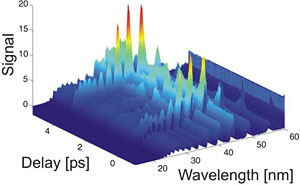Attosecond Dynamics
What is High Harmonic Generation?
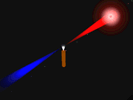
High harmonic generation describes the conversion of laser radiation from one fixed frequency to high harmonics of that frequency. This happens in a atomic or molecular jet (white cloud coming out of the orange nozzle in the movie). We need high laser fields to drive the process and therefore we focus intense red fs-pulses onto the gas jet. After the pulse (travelling from right to left) passes the jet, it has blue colored components. The radiation in this pulse extends into the ultraviolet and vacuum ultraviolet.
The details of the laser matter interaction in the gas jet:
The laser pulse has a strong electromagnetic field, where the electric field is much larger than the magnetic field. The electric field of the laser can get as strong as the field between electron and proton.
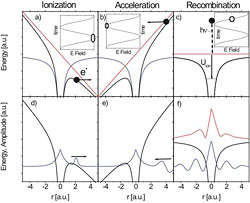
The picture on the left side summarizes the details of the high harmonic generation process. The upper row (a-c) represents a classical point of view, the bottom row depicts the same steps with the quantum wave function (d-f).
The electron sits unperturbed in the Coulomb potential (black line) of an atom. The laser field is very strong (~1010V/m) and adds the red potential. In the superposition, the potential is bend down and the electron can tunnel through the barrier. The ionization is the highest at the field maxima (a+d).
The electron is now accelerated in the laser field to energies of several eV. For distinct ionization times, the electron returns and recollides with the atom from which it was born (b+e).
Upon recollision, the electron kinetic energy is transferred into photons. The maximal kinetic energy of the electron is 3.2 times the ponderomotive potential Up=e2E2/(4mew2laser), where E is the electric field of the laser, e is the electron charge, me its mass and wlaser the laser angular frequency. The recollsion leads to the emission of a single, very broad light spectrum (c+f).
The ionization-recollision happens on each half cycle of the laser pulse. The spectra generated on each half cycle are added coherently, which leads to a structuring of the emitted spectrum into odd harmonics. Therefore, the process is called high harmonic generation. With strong laser pulses light up to the 51st harmonic and beyond is visible, reaching up to the soft Xray range.
What do we find out?
In quantum mechanics, the recolliding electron is represented as a de Broglie wave. This wave shifts over the molecular or atomic orbital, from which it was originally ionized. During this shifts, interferences occur, that modulate the amplitude and phase of the harmonic radiation.
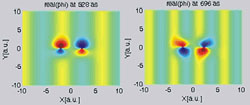
The graph exemplifies the interference on the highest molecular orbital (HOMO) of the CO2 molecule (the two lobes in the middle). The recolliding wave is shown at two different times. It interferes with the HOMO and thereby creates a dipole that radiates the harmonics. We are tracing the interferences from the harmonic spectra, measuring both their amplitude an phase.
The molecular features shape the emitted high harmonic light, opening the perspective to shape attosecond pulses.
Furthermore, the harmonic generation process can be used itself by observing short time electronic dynamics in the molecule.
How do we use High Harmonic Generation?
In our lab, we study high harmonic generation on molecules, that means we have molecules in the gas jet instead of atoms. Molecules have more degrees of freedom than atoms (the vibrations and rotations), and we can use them to shape the high harmonic spectrum. To determine the electronic structure of the molecule, we need to fix their axes in space by molecular alignment.
Molecular Alignment and High Harmonic Generation

Usually, the internuclear axis of molecules randomly oriented at any given time. By the interaction with a strong infrared, nonresonant laser pulse (shown red), all internuclear axes in an ensemble can be forced to align in one direction. The laser induces a dipole in the molecules, that is strongest parallel to the internuclear axis. This dipole aligns with the linear polarization of the laser field, and thereby forces the molecules into alignment.
Classically, the molecules will align best shortly after the laser pulse has passed.
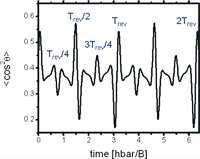
Due to their small size, the molecules do not follow the laws of classical physics. A quantum mechanical description describes their behaviour. In the quantum world, the alignment of the wave packet occurs not only one time, but repeatetly in so called revivals. The graph on the left side shows the alignment as a function of time. The alignment parameter <cos2θ> is 1/3 for an isotropic ensemble. It reaches maximal and minimal values at the so called half and full revival denoted by Trev/2 and Trev. The revivals are typical for a coherent superposition of anharmonic quantum states and are very similar in anharmonic vibrational oscillators.
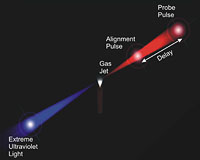
We perform the experiment in a pump-probe fashion: a first pump-pulse aligns the molecules and a second, stronger pulse creates high harmonics on the molecules.
The spectra are saved as a function of pump-probe delay, and we see a modulation in time of the harmonic intensity with the alignment. We use the modulation as a function of wavelength to calculate the interference structures in the harmonic generation.
